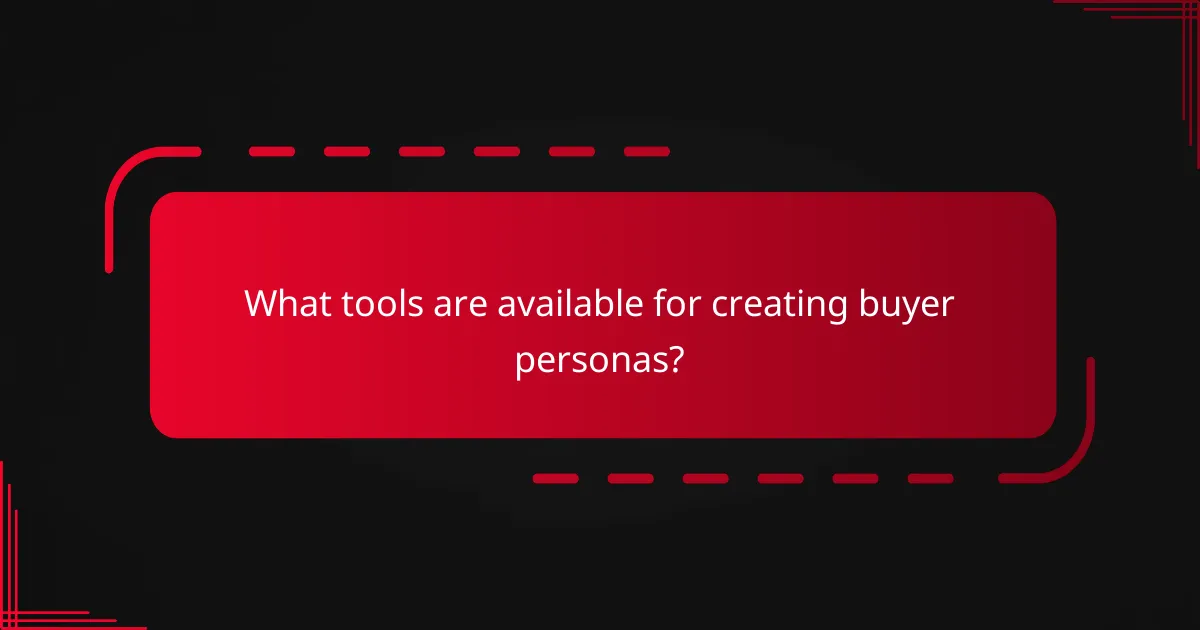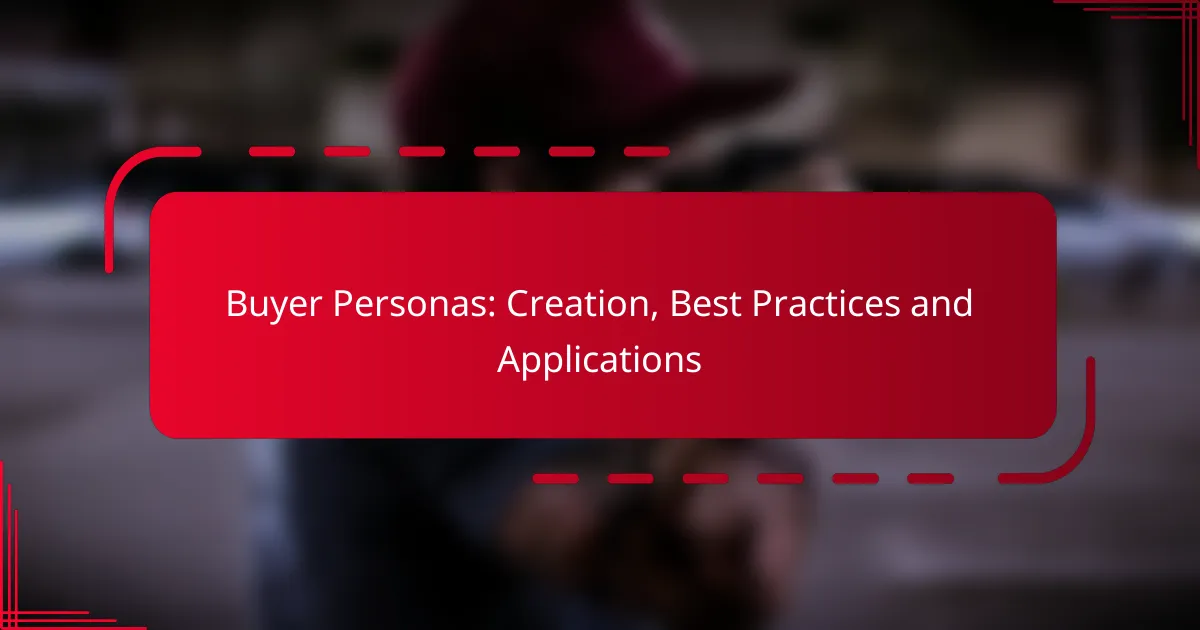Buyer personas are essential tools for understanding your target audience’s characteristics, preferences, and behaviors, particularly in display advertising. By creating detailed personas, businesses can tailor their marketing strategies to effectively meet the unique needs of different customer segments. Implementing best practices, such as collaboration and regular updates, ensures that these personas remain accurate and relevant, ultimately enhancing the effectiveness of advertising campaigns.

How to create effective buyer personas for display advertising?
Creating effective buyer personas for display advertising involves understanding your target audience’s characteristics, preferences, and behaviors. This process enables you to tailor your advertising strategies to meet the specific needs of different customer segments.
Identify target audience demographics
Start by identifying the key demographics of your target audience, such as age, gender, income level, education, and location. These factors help in creating a clear picture of who your ideal customers are and what they might be looking for in your products or services.
For instance, if your product is a luxury item, your target audience may primarily consist of individuals with higher income levels, typically aged 30-55. Understanding these demographics allows for more targeted advertising efforts.
Conduct surveys and interviews
Surveys and interviews are effective methods for gathering qualitative insights directly from your audience. Use online tools to create surveys that ask specific questions about preferences, challenges, and purchasing behaviors.
Consider conducting one-on-one interviews with a select group of customers to gain deeper insights. This qualitative data can reveal motivations and pain points that quantitative data might miss.
Analyze customer data
Utilizing existing customer data is crucial for refining your buyer personas. Analyze purchase history, website interactions, and customer feedback to identify patterns in behavior and preferences.
Look for trends such as common products purchased together or frequently visited pages on your website. This analysis can help you understand what drives your customers’ decisions and how to better meet their needs.
Segment personas by behavior
Behavioral segmentation involves categorizing your buyer personas based on their actions and interactions with your brand. This can include their buying frequency, product usage, and engagement with your marketing efforts.
For example, you might have a persona for frequent buyers who respond well to loyalty programs and another for occasional shoppers who need more incentives to make a purchase. Tailoring your strategies to these segments can enhance your advertising effectiveness.
Utilize tools like HubSpot
Leverage tools such as HubSpot to streamline the creation and management of your buyer personas. HubSpot offers features that help in collecting data, analyzing customer interactions, and visualizing personas.
Using such tools can save time and ensure that your personas are based on accurate, up-to-date information. Additionally, they often provide templates and resources to guide you through the persona development process.

What are the best practices for developing buyer personas?
Best practices for developing buyer personas involve a collaborative approach, ongoing updates, and a focus on understanding customer needs. By engaging various teams and refining personas regularly, businesses can create accurate representations that drive effective marketing strategies.
Involve cross-functional teams
Engaging cross-functional teams is crucial for developing comprehensive buyer personas. Involving members from sales, marketing, customer support, and product development ensures diverse insights and a well-rounded understanding of customer behaviors and preferences.
To facilitate collaboration, consider organizing workshops or brainstorming sessions where team members can share their experiences and observations about customers. This collective input can reveal patterns and nuances that a single department might overlook.
Regularly update personas
Buyer personas should not be static; they require regular updates to remain relevant. Market conditions, customer preferences, and business offerings evolve, making it essential to revisit and revise personas periodically, ideally every six months to a year.
To keep personas current, gather feedback from customer interactions, analyze new data, and monitor industry trends. This practice helps ensure that your marketing strategies align with the latest customer insights and needs.
Focus on pain points and goals
Understanding customer pain points and goals is fundamental to creating effective buyer personas. Identify the challenges your target audience faces and the objectives they aim to achieve, as this information will guide your marketing messaging and product development.
Use surveys or interviews to uncover these insights. For example, if your persona is a small business owner, their pain points might include limited resources and time constraints, while their goals could involve increasing revenue and improving efficiency.
Use real customer stories
Incorporating real customer stories into your buyer personas adds depth and authenticity. These narratives provide context and illustrate how customers interact with your products or services, making personas more relatable and actionable.
Collect case studies or testimonials that highlight specific customer experiences. For instance, a story about how a customer overcame a challenge using your product can help shape the persona’s characteristics and inform your marketing strategies.

How can buyer personas improve display advertising campaigns?
Buyer personas enhance display advertising campaigns by providing insights into the target audience’s preferences, behaviors, and needs. This understanding allows marketers to tailor their strategies, leading to more effective ad placements and messaging.
Enhance targeting precision
Creating detailed buyer personas allows advertisers to identify specific audience segments, improving targeting precision. By understanding demographics, interests, and online behaviors, campaigns can be directed towards the most relevant users, reducing wasted impressions and increasing engagement.
For example, a tech company might develop personas for both young professionals and retirees, ensuring that ads for new gadgets are shown primarily to the younger group, while retirement planning services are targeted at older adults.
Increase ad relevance
When ads are aligned with the interests and needs of specific buyer personas, their relevance increases significantly. This relevance captures attention and encourages interaction, as users are more likely to engage with content that resonates with their experiences or aspirations.
For instance, a fitness brand might create ads featuring workout gear specifically designed for busy moms, making the message more appealing to that segment compared to a generic fitness ad.
Improve conversion rates
Improved targeting and relevance often lead to higher conversion rates. When ads speak directly to the needs of the audience, users are more likely to take action, whether that’s clicking through to a website or making a purchase.
Research suggests that campaigns using buyer personas can see conversion rates increase by significant margins, often ranging from 20% to 50%, depending on how well the personas are defined and utilized.
Optimize ad creatives
Buyer personas inform the development of ad creatives, ensuring that visuals and messaging resonate with the target audience. This optimization can include everything from the choice of images to the tone of the copy, making ads more compelling.
For example, a brand targeting millennials might use vibrant colors and casual language, while an ad aimed at professionals might adopt a more sophisticated design and formal tone. Testing different creatives based on persona insights can further refine effectiveness.

What frameworks can guide buyer persona creation?
Frameworks for buyer persona creation help marketers understand their target audience more deeply. Two effective frameworks are empathy maps and customer journey mapping, which provide insights into customer motivations and experiences.
Empathy maps
Empathy maps are visual tools that help teams understand the feelings, thoughts, and behaviors of their target audience. They typically include sections for what customers say, think, do, and feel, allowing for a holistic view of the persona.
To create an empathy map, gather qualitative data through interviews or surveys. Focus on identifying key pain points and desires, which can inform product development and marketing strategies. A common pitfall is relying solely on assumptions; always validate insights with real customer feedback.
Customer journey mapping
Customer journey mapping outlines the steps a buyer takes from awareness to purchase and beyond. This framework highlights touchpoints where customers interact with your brand, helping to identify opportunities for improvement.
When creating a customer journey map, consider stages such as awareness, consideration, decision, and post-purchase. Use insights from customer feedback and analytics to pinpoint areas where customers may experience friction. Avoid making the map too complex; keep it clear and focused on key interactions to ensure it remains actionable.

What tools are available for creating buyer personas?
Several tools can assist in creating buyer personas, each offering unique insights and data. Utilizing a combination of analytics platforms and persona-building software can enhance the accuracy and effectiveness of your personas.
Use Google Analytics for insights
Google Analytics provides valuable data on user behavior, demographics, and interests, which are crucial for developing buyer personas. By analyzing metrics such as age, gender, location, and user engagement, you can identify trends that inform your persona creation.
To get started, navigate to the Audience section in Google Analytics. Look for reports that highlight user characteristics and behaviors, focusing on segments that align with your target market. This data can help you create detailed profiles that reflect your ideal customers.
Leverage social media analytics
Social media platforms like Facebook, Twitter, and LinkedIn offer analytics tools that provide insights into your audience’s preferences and behaviors. These insights can reveal what content resonates with your audience and help refine your buyer personas.
Utilize features such as audience demographics, engagement rates, and follower growth to gather data. Pay attention to the types of posts that generate the most interaction, as this can indicate the interests and needs of your target personas.
Explore platforms like Xtensio
Xtensio is a user-friendly platform designed specifically for creating and managing buyer personas. It offers customizable templates that allow you to easily compile data and insights into visually appealing persona documents.
Using Xtensio, you can collaborate with team members in real-time, ensuring that everyone contributes to the persona development process. This collaborative approach can lead to more comprehensive and accurate buyer personas that reflect diverse perspectives within your organization.
